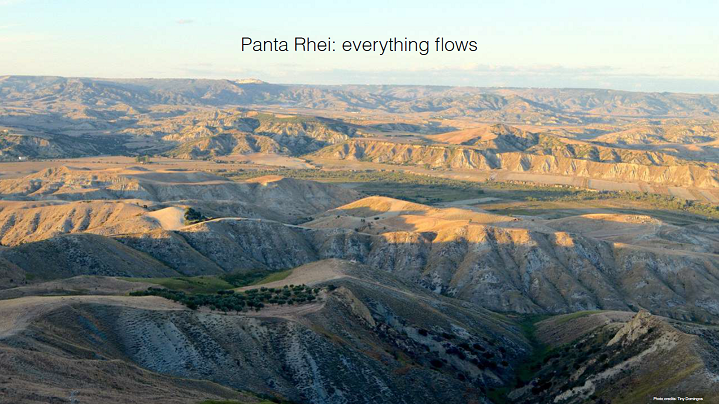In curiosity we find innovation.
Artist in residence Tiny Domingos and scientist Monica Cardarilli presented the collaboration that had begun with Tiny’s residencies on the 30th November 2021 at JRC. Under the theme "Not all crises can be prevented but you are not alone", they discussed how risk management, eco-sustainability, resilience and remediation meet in the framework of art and science.
The talk invited the public to look at nature under a different light, and face the future with confidence through a plural approach that includes science, art and planetary health. Tiny and Monica spoke about the need to ferment agency, to open up perspectives on soil (usually seen as solid foundation and inert matter), the fatality of natural disasters and geo-hazards, and more generally how transdisciplinary approaches such as SciArt help move towards towards global resilience.
Tiny Domingos guided us through his research for the LANDSLIDE project and presented the main works produced for the Resonances III / DATAMI Festival. Monica Cardarilli spoke about the numerous correlations and implications of landslide disasters and the need for a holistic approach to them.
LANDSLIDE is tangential to the Green Deal and Digital Strategy of the European Commission and the Sendai Framework for Disaster Risk Reduction of the United Nations. Moreover, it touches on the current climate crisis discussions and the post-humanist perspective of "de-centring the human", bridging the Human/Non-Human divide.

Their talk was structured in three parts. First, Tiny’s past (and ongoing) fascination with landslides as critical masses that reconfigure the ground, which had motivated his work for Resonances III. Next, the present connection with Monica, who worked on landslides for her PhD, and their shared interest in risk management and resilience. They advocated for flexibility and a readiness to adapt when faced with changes or natural disasters; so we can land smoothly, instead of falling. In such shifting circumstances, Tiny stressed the need to reconnect to the soil, and understand that it is alive and subject to change as we are.
They discussed the importance of art in these scenarios, as art can help us face and overcome change, humanising science and connecting it to society. Metaphors in art and literature thus intersect the natural phenomena of landslides in multiple forms, including scientific databases and models, inspiring people towards change and resilience. In curiosity we find innovation.
Lastly, with an eye to future developments, they proposed more collaborations within the JRC, with a “resilience chain” of people working together through trauma, to recover a balance with the natural world, facilitated by the bridging role of SciArt. This work should be grounded in the notion that we need more respect to achieve the convergence of human and natural. In this way, we can move on from crises and get a step closer to NaturArchy, deriving hope and re-connection from the soil.
